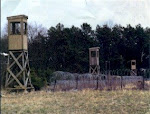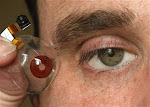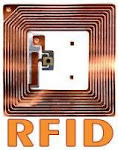 HITACHINAKA,Japan-The new toddler-like robot from Hitachi rolled around and waved in a demonstration Wednesday, only to crash into a desk, highlighting the hurdles robots must overcome to become real-life partners.Never mind that the 31.5-inch-tall, 29-pound machine could scoot on two wheels, get on its knees to move on four wheels and even lift its foot about an inch to step over thresholds and bumps.The red and white robot, designed to work as a guide and run errands in offices, wasn't prepared for the jam of lunch-break wireless and Internet traffic at Hitachi Ltd.'s research center and smashed into a desk right in the middle of a demonstration. Watching reporters gasped and a demonstrator reached out in the nick of time to catch the robot by its winglike handles before it toppled over, unable to receive the wireless commands from the person controlling the robot by remote from a nearby laptop.Robots are mostly used as industrial machinery and entertainment gadgets. But Hitachi's new robot is the latest attempt by several Japanese companies to develop one that can play roles as assistants in daily life. Engineers are working hard to create robots that run smoothly and safely so that people aren't hurt.In 2005, Hitachi had shown the robot's 51-inch-tall predecessor. The original EMIEW, which stands for "excellent mobility and interactive existence as workmate," packed all the computer functions internally but weighed four times as much.The improved EMIEW 2 shed some pounds to become safer to be around people. It's designed to be light enough for a person to carry around. Its key feature is its ability to shift from moving on two wheels to a more stable position on four wheels.But the new remote wireless control function was at the heart of its collision problems. Japan is among the world's leaders in robotics, and the government is pushing major companies like Hitachi to develop robots for practical use.Honda Motor Co. and Toyota Motor Corp. also have developed human-like robots that reporters have seen working as guides at the Japanese automakers' facilities. Other electronics makers such as NEC Corp. and Fujitsu have shown robots, but Sony Corp. has discontinued the Aibo dog-shaped entertainment robot.Hitachi declined to say when the robot would be ready for commercial use. It refused to say how much the robot cost or how much it spent on its research.EMIEW 2 did its job perfectly for a while, wheeling around, cocking its red, caplike plastic head and waving its arms in a room at the Hitachi research center.It also showed voice recognition capabilities, appearing to understand human speech in Japanese.When a person asked where a certain Mr. Nakamura was sitting, it responded in a boylike electronic voice: "I will take you there. Follow me."But seconds later, when it tried to maneuver between two desks, it smashed into one of them.Reporters had to wait for an hour until after the lunch break to watch the robot repeat the demonstration, this time smoothly making its way between the desks.Developers said the robot had performed fine on test runs but acknowledged kinks had to be worked out so it can properly receive wireless commands. Besides the collision, it also suddenly stood motionless at one point."We are studying what hurdles need to be overcome to make robots practical," said Hitachi researcher Takashi Teramoto. "One characteristic we feel we need to ensure for robots is safety."EMIEW 2 robot comes with a gyrosensor to maintain its balance, lithium ion batteries for an hour worth of power before recharging and a laser radar to map out its surroundings in its computer brain, according to Hitachi. It can also dodge human-size obstacles in its way, the Tokyo-based company said.
HITACHINAKA,Japan-The new toddler-like robot from Hitachi rolled around and waved in a demonstration Wednesday, only to crash into a desk, highlighting the hurdles robots must overcome to become real-life partners.Never mind that the 31.5-inch-tall, 29-pound machine could scoot on two wheels, get on its knees to move on four wheels and even lift its foot about an inch to step over thresholds and bumps.The red and white robot, designed to work as a guide and run errands in offices, wasn't prepared for the jam of lunch-break wireless and Internet traffic at Hitachi Ltd.'s research center and smashed into a desk right in the middle of a demonstration. Watching reporters gasped and a demonstrator reached out in the nick of time to catch the robot by its winglike handles before it toppled over, unable to receive the wireless commands from the person controlling the robot by remote from a nearby laptop.Robots are mostly used as industrial machinery and entertainment gadgets. But Hitachi's new robot is the latest attempt by several Japanese companies to develop one that can play roles as assistants in daily life. Engineers are working hard to create robots that run smoothly and safely so that people aren't hurt.In 2005, Hitachi had shown the robot's 51-inch-tall predecessor. The original EMIEW, which stands for "excellent mobility and interactive existence as workmate," packed all the computer functions internally but weighed four times as much.The improved EMIEW 2 shed some pounds to become safer to be around people. It's designed to be light enough for a person to carry around. Its key feature is its ability to shift from moving on two wheels to a more stable position on four wheels.But the new remote wireless control function was at the heart of its collision problems. Japan is among the world's leaders in robotics, and the government is pushing major companies like Hitachi to develop robots for practical use.Honda Motor Co. and Toyota Motor Corp. also have developed human-like robots that reporters have seen working as guides at the Japanese automakers' facilities. Other electronics makers such as NEC Corp. and Fujitsu have shown robots, but Sony Corp. has discontinued the Aibo dog-shaped entertainment robot.Hitachi declined to say when the robot would be ready for commercial use. It refused to say how much the robot cost or how much it spent on its research.EMIEW 2 did its job perfectly for a while, wheeling around, cocking its red, caplike plastic head and waving its arms in a room at the Hitachi research center.It also showed voice recognition capabilities, appearing to understand human speech in Japanese.When a person asked where a certain Mr. Nakamura was sitting, it responded in a boylike electronic voice: "I will take you there. Follow me."But seconds later, when it tried to maneuver between two desks, it smashed into one of them.Reporters had to wait for an hour until after the lunch break to watch the robot repeat the demonstration, this time smoothly making its way between the desks.Developers said the robot had performed fine on test runs but acknowledged kinks had to be worked out so it can properly receive wireless commands. Besides the collision, it also suddenly stood motionless at one point."We are studying what hurdles need to be overcome to make robots practical," said Hitachi researcher Takashi Teramoto. "One characteristic we feel we need to ensure for robots is safety."EMIEW 2 robot comes with a gyrosensor to maintain its balance, lithium ion batteries for an hour worth of power before recharging and a laser radar to map out its surroundings in its computer brain, according to Hitachi. It can also dodge human-size obstacles in its way, the Tokyo-based company said.As in the days of Noah....






















































































.bmp)

























.bmp)